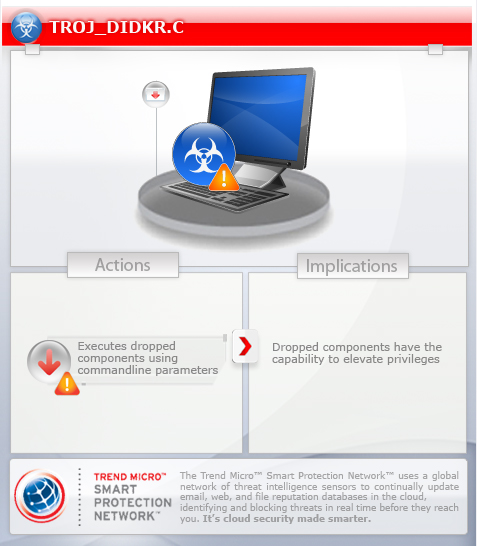TROJ_DIDKR.C
Windows 2000, Windows Server 2003, Windows XP (32-bit, 64-bit), Windows Vista (32-bit, 64-bit), Windows 7 (32-bit, 64-bit)


Threat Type: Trojan
Destructiveness: No
Encrypted: Yes
In the wild: Yes
OVERVIEW
It drops a distributed denial of service (DDoS) component that targets primary and secondary DNS name servers of record for multiple South Korean government sites.
To get a one-glance comprehensive view of the behavior of this Trojan, refer to the Threat Diagram shown below.

This malware drops several components depending on the operating system of the affected system, whether 32- or 64-bit. It ends with the dropping of a malicious executable that performs the distributed denial of service attack on predetermined IP addresses belonging to South Korea government websites.
This Trojan may be downloaded by other malware/grayware/spyware from remote sites.
It executes the dropped file(s). As a result, malicious routines of the dropped files are exhibited on the affected system.
TECHNICAL DETAILS
Arrival Details
This Trojan may be downloaded by other malware/grayware/spyware from remote sites.
Installation
This Trojan drops the following file(s)/component(s):
- 64-bit environment:
- %User Temp%\~ER{number}.tmp (64-bit) - detected as HKTL_BYPASS
- %User Temp%\~DR{number}.tmp (64-bit) - detected as TROJ64_DIDKR.C
- 32-bit environment:
- %User Temp%\~DR{number}.tmp (32-bit) - detected as TROJ_DIDKR.C
(Note: %User Temp% is the current user's Temp folder, which is usually C:\Documents and Settings\{user name}\Local Settings\Temp on Windows 2000, XP, and Server 2003, or C:\Users\{user name}\AppData\Local\Temp on Windows Vista and 7.)
Other System Modifications
This Trojan adds the following registry entries:
HKEY_LOCAL_MACHINE\SYSTEM\CurrentControlSet\
Services\{service name of variable 1}Svc\Parameters
ServiceDll = “%System%\ole{variable 1}.dll”
HKEY_LOCAL_MACHINE\SYSTEM\CurrentControlSet\
Services\{service name of variable 1}Svc\Parameters
ServiceMain = “RoutineMain”
It modifies the following registry entries:
HKEY_LOCAL_MACHINE\SOFTWARE\Microsoft\
Windows NT\CurrentVersion\SvcHost
netsvcs = “{default data}, {service name of variable 1}Svc”
(Note: The default value data of the said registry entry is {default data}.)
Dropping Routine
This Trojan executes the dropped file(s). As a result, malicious routines of the dropped files are exhibited on the affected system.
NOTES:
This malware executes the dropped components in 64-bit environment using the following command line parameters:
- "%User Temp%\~ER{number}.tmp" "%User Temp%\~DR{number}.tmp"
The dropped component %User Temp%\~ER{number}.tmp is capable of elevating administration privileges of ~DR{number}.tmp in default user access control (UAC) settings. The component %User Temp%\~DR{number}.tmp drops the following files:
- 64-bit environment:
- %System%\ole{variable 1}.dll (64-bit) - detected as TROJ64_DIDKR.C
- %User Temp%\~DL{number}.tmp (64-bit) - copy of ole{variable 1}.dll (64-bit)
- 32-bit environment:
- %System%\ole{variable 1}.dll (32-bit) - detected as TROJ_DIDKR.C
- %User Temp%\~DL{number}.tmp (32-bit) - copy of ole{variable 1}.dll (32-bit)
It enumerates all service names that meets the following condition:
- ImagePath = "%SystemRoot%\System32\svchost.exe -k netsvcs"
It then gets {variable 1} from the file name registered in ServiceDll. For example:
ImagePath = "%SystemRoot%\System32\svchost.exe -k netsvcs
ServiceDll = "%System%\shsvcs.dll"
{variable 1} = shsvcs
Thus, the file ole{variable 1}.DLL is dropped as oleshsvcs.DLL in the aforementioned scenario.
The component %System%\ole{variable 1}.dll accesses any of the following sites to receive data:
- http://webmail.{BLOCKED}shost.com/mail/images/ct.jpg
- http://www.{BLOCKED}pic.net/pictures/e02947e8573918c1d887e04e2e0b1570.jpg
It saves the received data to %User Temp%\~MR{number}.TMP. It checks the content of %User Temp%\~MR{number}.tmp if the string BM6W is present. As of this writing, it checks the present date if equal to or greater than June 25 10AM. The date to be compared is present in the received data. It is the 4 bytes of data after BM6W.
The component %System%\ole{variable 1}.DLL drops and executes the following file if the conditions above are met:
- %System%\wuauieop.exe - detected as DDOS_DIDKR.C
SOLUTION
Step 1
Before doing any scans, Windows XP, Windows Vista, and Windows 7 users must disable System Restore to allow full scanning of their computers.
Step 2
Remove malware/grayware files dropped/downloaded by TROJ_DIDKR.C
Step 3
Identify and delete files detected as TROJ_DIDKR.C using either the Startup Disk or Recovery Console
Step 4
Delete this registry value
Important: Editing the Windows Registry incorrectly can lead to irreversible system malfunction. Please do this step only if you know how or you can ask assistance from your system administrator. Else, check this Microsoft article first before modifying your computer's registry.
- In HKEY_LOCAL_MACHINE\SYSTEM\CurrentControlSet\Services\{service name of variable 1}Svc\Parameters
- ServiceDll = “%System%\ole{variable 1}.dll”
- ServiceDll = “%System%\ole{variable 1}.dll”
- In HKEY_LOCAL_MACHINE\SYSTEM\CurrentControlSet\Services\{service name of variable 1}Svc\Parameters
- ServiceMain = “RoutineMain”
- ServiceMain = “RoutineMain”
Step 5
Restore this modified registry value
Important: Editing the Windows Registry incorrectly can lead to irreversible system malfunction. Please do this step only if you know how or you can ask assistance from your system administrator. Else, check this Microsoft article first before modifying your computer's registry.
- In HKEY_LOCAL_MACHINE\SOFTWARE\Microsoft\Windows NT\CurrentVersion\SvcHost
- From: netsvcs = “{default data}, {service name of variable 1}Svc”
To: netsvcs = "{default data}"
- From: netsvcs = “{default data}, {service name of variable 1}Svc”
Step 6
Search and delete this file
There may be some component files that are hidden. Please make sure you check the Search Hidden Files and Folders checkbox in the More advanced options option to include all hidden files and folders in the search result.
- %User Temp%\~MR{number}.tmp
Step 7
Scan your computer with your Trend Micro product to delete files detected as TROJ_DIDKR.C. If the detected files have already been cleaned, deleted, or quarantined by your Trend Micro product, no further step is required. You may opt to simply delete the quarantined files. Please check this Knowledge Base page for more information.
Did this description help? Tell us how we did.


